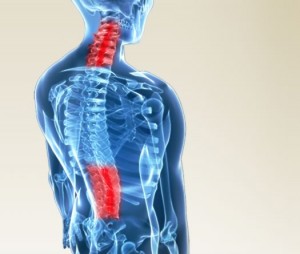Herniated Disc
Posted on May 16th, 2012 by Andries Lodder
You’ve probably heard people say they have a “slipped” or “ruptured” disk in their neck or lower back. What they’re actually describing is a herniated disk, a common source of neck, or lower back and arm or leg pain.
Disks are soft, rubbery pads found between the hard bones (vertebrae) that make up the spinal column. In the middle of the spinal column is the spinal canal-a hollow space that contains the spinal cord and other nerve roots. The disks between the vertebrae allow the back to flex or bend. Disks also act as shock absorbers.
Disks in the lumbar spine (low back) are composed of a thick outer ring of cartilage (annulus) and an inner gel-like substance (nucleus). In the cervical spine (neck), the disks are similar but smaller in size. A helpful comparison is a jelly donut: its thick outer portion represents the annulus, while the jelly is similar to the nucleus.
A disk herniates or ruptures when part of the center nucleus pushes through the outer edge of the disk. To continue with the donut analogy, the jelly pushes backwards toward the spinal canal. This puts pressure on the nerves. Spinal nerves are very sensitive to even slight amounts of pressure. Pain, numbness or weakness may occur in one or both legs.
Risk Factors
In children and young adults, disks have high water content. As people age, the water content in the disks decreases. They become less flexible. The disks begin to shrink. The spaces between the vertebrae get narrower. The disk itself becomes less flexible. Conditions that can weaken the disk include:
- Improper lifting
- Smoking
- Excessive body weight that places added stress on the disks (in the lower back)
- Sudden pressure (which may be slight)
- Repetitive strenuous activities
Symptoms
Lower Back: Low back pain affects four out of five people. Pain alone isn’t enough to recognize a herniated disk. See your doctor if back pain results from a fall or a blow to your back. The most common symptom of a herniated disk is sciatica-a sharp, often shooting pain that extends from the buttocks down the back of one leg. It is caused by pressure on the spinal nerve. Other symptoms include:
- Weakness in one leg
- Tingling (a “pins-and-needles” sensation) or numbness in one leg or buttock
- Loss of bladder or bowel control (If you also have significant weakness in both legs, you could have a serious problem. Seek immediate attention.)
- A burning pain centered in the neck
Neck: Like pain in the lower back, neck pain is also common. When pressure is placed on a nerve in the neck, it causes pain in the muscles between your neck and shoulder (trapezial muscles). The pain may shoot down the arm. Sometimes the pain causes headaches in the back of the head. Other symptoms include:
- Weakness in one arm
- Tingling (a “pins-and-needles” sensation) or numbness in one arm
- Loss of bladder or bowel control (If you also have significant weakness in both arms or legs, you could have a serious problem. Seek immediate attention.)
- Burning pain in the shoulders, neck or arm
Treatment Options
Conservative treatment is effective in treating symptoms of herniated disks in more than 90 percent of patients. Most neck or back pain will resolve gradually with simple measures.
If you suffer from the above, don’t delay, go seek advice from a medical practitioner near you!
Tweet
